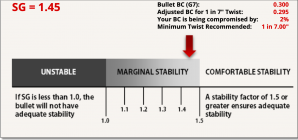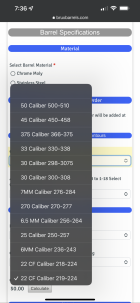I've blown up Berger 90 VLDs @ ~2850 fps, and the Hornady 88s @ ~2830 fps in this 6.8-twist barrel. 2830 fps in a 6.8-twist barrel translates to ~299.7K RPM, and 2850 fps to ~ 301.8K RPM. In a 7-twist barrel, the RPM values drop to the 291K to 293K range. I don't know if the "straw that broke the camel's back" point lies in between those two ranges, but I do know I've never lost a 90 VLD from a 7.0-twist barrel at the same velocity (2850 fps). Further, I've recently been shooting Sierra 90 SMKs at ~2850 fps and Sierra 95 SMKs at ~2750 fps out of the same out of the 6.8-twist barrel, and not had any jacket issues with either one. So it's hard to say definitively whether the barrel has any issues; however, I'm inclined to doubt it given the lack of any jacket issues with two different Sierra bullets.
There is a lengthy thread on jacket issues with the Hornady ELDM bullets that has led me to suspect contacting them about this issue wouldn't be of much help, but in fairness, I have not tried. I have contacted Berger about the jacket issues with the 90 VLDs on multiple occasions. The take home message was essentially that if I'm going to run them over 300K RPM, all bets are off.
The main consideration with the 95 SMKs and 88 ELDMs is that they have very long bearing surfaces, which require considerable freebore to seat them optimally in a .223 Rem case. The 6.8-twist barrel has 0.220" freebore, which is sufficient, although 0.250" or 0.275" would be even better IMO. My .223 with a 7-twist barrel does not have sufficient freebore to seat either of those bullets optimally. Eventually, I'll replace the 6.8-twist barrel(s) as a 7-twist is sufficient for either one of those bullets. However, the current barrel only has about 1500 rounds through it and I had a second identical barrel chambered when the rifle was built. That is why I've worked up loads with the two Sierra bullets, so that I don't lose the use of that rifle in F-TR competition with the barrels I currently have. If you ever lose a jacket in the middle of a match where you were competing for the win, the confidence level drops to zero pretty quickly.
I generally consider barrels an expendable commodity, but the 6.8-twist barrels are also threaded for a tuner. Collectively, I'd rather not just throw away the cost of half-life barrel and a brand new one if I can find a bullet/load combination that is tolerant of the faster twist rate. Eventually, they'll both be shot out and subsequently replaced with 7-twist barrels having sufficient freebore to load the 88s optimally. Ulitmately, my issues might stem from that specific fast twist barrel I've been using, the velocity I'm pushing these bullets, or might even be a Lot#-specific bullet problem. But it's hard to definitively pinpoint exactly where the problem originates. Nonetheless, as long as I have something else that works, I won't lose the use of the rifle. Eventually, I'd like to shoot those 88s again because except for the jacket failures, I was very pleased with how easily they tuned in and the precision they offered.













